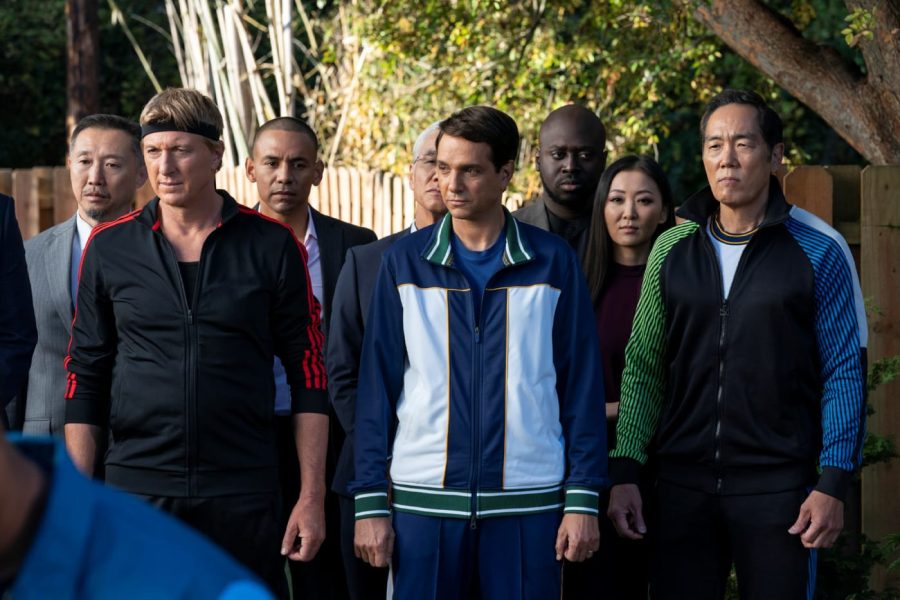In a world of mediocre spinoffs of older movies, Netflix’s “Cobra Kai” manages to be unexpectedly original and interesting.
The show revolves around Johnny Lawrence, the main antagonist in “The Karate Kid,” following his life after losing the All Valley to “Karate Kid’s” protagonist, Daniel LaRusso, back in 1984. Season 5 of Cobra Kai was a big hit on Netflix, with 106.7 million viewing hours logged in just three days.
Steeped in ‘80s nostalgia, the well-placed jokes and gags placed next to compelling and well-written drama make “Cobra Kai’s” first four seasons some of Netflix’s best work. The show stars Ralph Macchio, William Zabka, Martin Kove, Peyton List, Xolo Mariduena, Mary Mouser, Tanner Buchanan and Thomas Ian Griffith.
“Cobra Kai’s” fourth season left fans at the edge of their seats. Terry Silver has taken over the Cobra Kai dojo from Kreese, who is now in prison for assault. Furthermore, Cobra Kai currently possesses the All Valley winning title with Tory Nichols as the reigning champion.
However, former All Valley champion Miguel Diaz left the tournament after suffering an injury, without informing his parents or Lawrence, to go to Mexico and meet his father. Robby Keene and Lawrence have gone to Mexico to search for Diaz, the real reason why Diaz left being unbeknownst to them.
Meanwhile, back in California, Silver has tightened his grip on the Valley, determined to spread the ideals of Cobra Kai. The only people that stand to oppose him are LaRusso, intent on preserving the ideals of Nariyoshi Miyagi, Chozen Toguchi, and Okinawan martial arts master and the major antagonist in “Karate Kid Part II,” and a reluctant Lawrence, now a soon to be father still reliving his ‘80s glory days.
The show certainly took time to reach its stride, as the first two episodes were mostly pointless, meandering around only for the whole subplot with Diaz’s dad to be completely abandoned. The only purpose it might’ve served was wrapping up the tension between Diaz and Lawrence from season four by showing that Lawrence cared enough about Diaz to come rescue him. Nevertheless, there were certainly better ways to do this than a poorly developed subplot.
However, the third episode hints at the greatness that season eventually captures. One of these examples is an emotional breakup scene between Diaz and Samantha LaRusso. Samantha tells Diaz that while she still wants to be friends, she needs to take a break from the karate side of her life. The whole scene is beautifully acted and displays a more emotional aspect for both characters, showing a more mature side of Diaz and a more sensitive side of Samantha.
The other parts of the show take a little bit longer to catch up. Chozen and Daniel are trying to take down Silver, but at every step, Silver seems to outsmart them.
In one of my personal favorite “Karate Kid” throwbacks, Mike Barnes, “karate’s bad boy,” returns, now a mild mannered furniture store owner who is happy to help out Daniel however he can. This is one of many meticulously detailed throwbacks from the “Karate Kid” movies.
If anything, the show stays very true to its source material. My favorite returning character was definitely Chozen, but in season five, we do see more good callbacks to previous installments. Karate master Kim Sun Young, a major player in the world building of season five, was sourced from a throwaway line in “Karate Kid Part III.” We see Jessica Andrews, a love interest also from “Karate Kid Part III,” reappear as a friend of Amanda LaRusso’s in episode four. We even see Lizzie Anne, mentioned only once in “Karate Kid Part III,” reappear as a minor antagonist.
While Cobra Kai’s fifth season was slow to start and had somewhat of an abrupt ending, the show, despite its sometimes dark tone, reminds us that people aren’t always what they seem and change is possible, even when it’s difficult.




